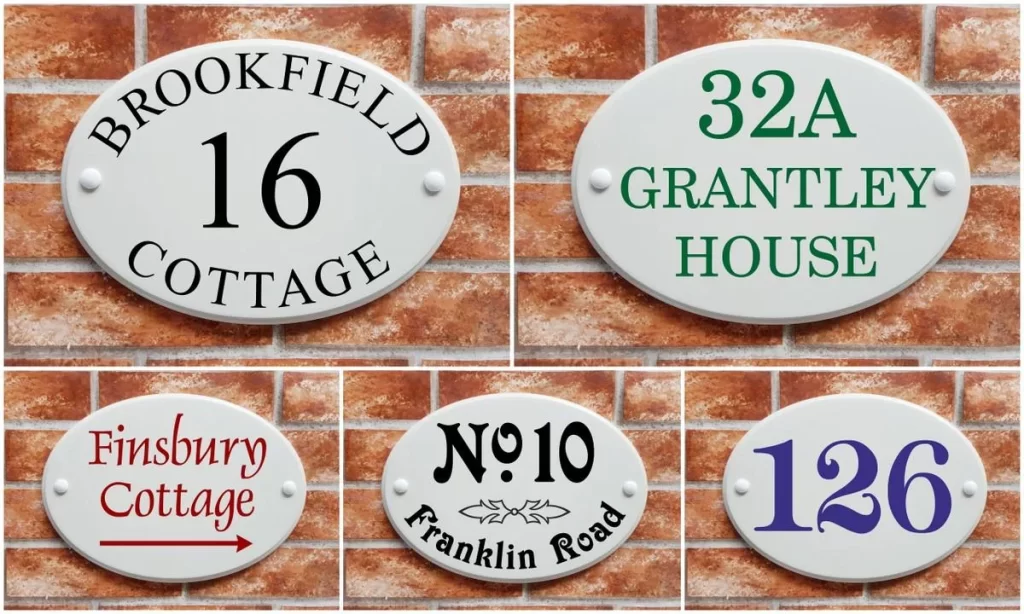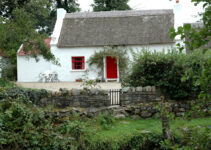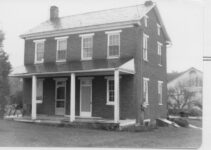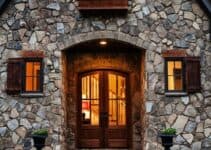The English have a love of naming their homes. You only need to think of the house names from literature and film to know the truth of this.
Think Pemberley, The Burrow, Manderley or Bag End and we’ve only scratched the surface.
And cottage names are no different. Do you know where Agatha Christie’s Miss Marple lived? You may remember it was in the village of St Mary Mead but did you know she lived in Danemead cottage? If not, you do now.
English cottage names are part and parcel of village life. And to this day you’ll find a Rose Cottage, Mill Cottage or Hollywell Cottage in many villages around the country.
But the central question remains: why do English cottages names? The answer is as long and convoluted as English history but the truth is that house names were around far longer than house numbers.
And, there are various reasons why English cottages and other dwellings have names.
So let’s look more closely at those reasons.
What’s the History Behind English Cottage Names?
The Earliest Cottage Names
It may be unsurprising to know that many of the earliest recorded house names in England were family oriented. England is a feudal country – a social system that stems back millennia.
At this point in history, most homes would have been cottages and part of the feudal hierarchy. This means that the dwelling would likely have been called after the head of the household.
So, cottages of this period may have been referred to as Ceowulf’s or Aethelfrith’s cottage.
We can still see the evidence of this in how we refer to our family and friends’ homes. We might say, “I’m just popping ‘round to Auntie Jean’s” – see? We’ve named the house after the person even if her cottage is really called Tide’s Reach.
But even in the past community dwellings had more generic names. Churches were dedicated to saints, people selling wares would have hung an item of their trade outside their cottage to state their business, and pubs would have been called something that meant something to the community.
Perhaps their establishment was near a hunting ground so would be called The Fox and Hound or the White Hart.
If it was near the coast it might be called The Crossed Keys to show you might be able to exchange money for contraband.
So it’s clear that the earliest dwelling names help to do a number of things: state the ownership of property, state a person’s business, or link it to its environment.

Cottage Names in the Middle Ages
Very little changes in the naming of English cottages after the Norman Conquest despite land ownership being carved up pretty ruthlessly between new Norman lords or English lords who supported William the Conqueror.
What you do find is the addition of thousands of Norman French words to the English language. So your new lord’s house might now be called Beaulieu Manoir rather than Arthur’s Hall.
But what did this period mean for more humble cottage names? Not very much really.
The baker would have still needed his flour from the miller, and the brewer his barrels from the cooper.
However, with greater stability and greater wealth, certain areas would need new housing so cottages would have been built by or for workers of that landowner.
The cottage may have housed a family but now the name would reflect what function the dwellers would perform for the landowner not the family name of those within
As an example, Mill Cottage might be home to those helping to run the mill itself. Likewise, Farm Cottage may have been built to house additional workers on the local farm.
And this type of cottage naming went on for many centuries.
The remnants of feudal ownership can still be seen in the painting of cottage front doors in certain parts of the country where villages are still under the ‘ownership’ of certain landowners.
Midhurst in East Sussex still has many cottages that are part of the Cowdray Estate. The Cowdray cottage door colour is a mustardy yellow.
And to the north, the Chatsworth Estate requires their cottages to sport a blue door.
Georgian and Victorian Cottage Names
It wasn’t until the industrial revolution changed the socio-economic dynamic of the English people and landscape so irrevocably that house numbers started to come into play.
And a trend which started in London around the late 1700s would soon spread elsewhere as urban areas expanded.
For urban planners numbers were more efficient than names. And the growth of tenements meant that cottages that may once have been on the outskirts of a town were now swallowed by it.
Thankfully the boom of the middle classes may be said to have saved the naming of cottages during this period.
The newly monied middle classes wanted an escape from the grubby streets of the town their factories were polluting. So buying a cottage by the sea or in the country was just the thing.
Couple this with the popular pastime of ‘taking the waters’ and you’ll see why the popularity of places like Bath and Buxton never waned.
In fact, if a middle-class family of wealth found no available properties in the area of their choice they did the next best thing – they had one built. Then they had the dilemma of naming it.
Queen Victoria was known for her love of Scotland and perhaps the love of the monarch during her reign is why you’ll find Victorian cottages named Ben Nevis or Loch Side, even if they are in Brighton or Bournemouth.
And the questionable cottage naming trend didn’t die with the monarch.
Edwardian Nostalgia for Quaint Cottage Names
The trend for ‘quaint’ cottage names didn’t diminish in the Edwardian period. And it may have been the result of the horrors of the Great War that cottages built and named during this period have a particularly nostalgic quality.
There is a distinct chocolate-box quality to many cottage names from the Edwardian period and you’ll find a host of Lilac, Rose or Ivy Cottages dotted around the country – even if they were built just two roads back from the High Street.
And there’s no doubt that the continued growth of the middle classes in Later Victorian and Edwardian times made cottage names something of an indication of the family’s social status.
So you might find a cottage that was once called Cooper’s Cott renamed Oak Lodge during this time. The word lodge may have been intended to evoke a connection to a fine estate – even when there was none nearby.
Cottage names during this time seem to either reflect ‘better’ times that were lost because of the huge loss of life during WWI or project a desire to escape the stigma of being formerly working class.
Your cottage name could be one indicator that you’d made it.
Modern Cottage Names
Nowadays homes are built for profit and convenience and, very similar to the town planners during the industrial revolution, sentiment doesn’t generally come into it so they’re more likely to be numbered.
House numbers are more convenient for the postal service too because of their chronology – they’re easy to find.
This isn’t universal, though. For new builds in some areas where house names are widely used a number would be strange.
And if a new cottage is detached and in a more rural area then it’s more likely to be named than numbered.
Renaming cottages is still a thing, though, especially if the existing cottage name is ugly or incongruous. New cottage owners might find a heavily extended or remodelled cottage called Little Cot a little ironic, so a name change becomes necessary.
So what do you do if you’ve just bought a beautiful English cottage but it has a terrible name? Don’t worry we’ve got you!
How Do You Name an English Cottage?
If you’re in the enviable position of being the proud new owner of an English cottage, lucky you! But if it’s got an unutterably awful name, you’d be forgiven for wanting to rename it.
And don’t worry about the superstition regarding renaming things – that only applies to boats.
So how do you name an English Cottage? The short answer is: however you want. But to help you out, we’ve pulled together a short list of ideas.
When naming your cottage consider:
Location and Surroundings: Consider the geographical features, landmarks, or natural elements around the cottage. It could be named after a nearby river, forest, hill, or any distinctive feature.
Historical Significance: Research the history of the cottage and its surroundings. Look for any historical events, famous figures, or folklore associated with the area that could inspire a name.
Architectural Features: Pay attention to the unique architectural elements of the cottage. If it has a thatched roof, a low doorways and ceilings, small windows or a distinctive chimney, you could incorporate these features into the name.
Personal Meaning: Think about the things that are significant to you or your family. It could be the name of a loved one, a favourite flower, an animal, or even a cherished memory.
Character and Personality: Consider the character and personality of the cottage. Is it cosy and quaint, rustic and rugged, or elegant and refined? Let the cottage’s charm guide you in finding a suitable name.
Local Tradition and Culture: Embrace the local culture and traditions of the area. You could use local dialect words or draw inspiration from a local tradition.
Wordplay and Alliteration: Play around with words and phrases to create a catchy and memorable name. Alliteration (using words that start with the same letter) can make the name even more charming. Some people find this a little naff, but if it works for you, go for it!
Avoiding Common Names: Try to create a unique name to give your cottage its own distinct identity. Steer clear of overused or generic names that might be found in many other properties. If you’re not sure which are popular read on, we mention them later.
Seeking Inspiration: Browse books, poems, or even online sources for inspiration. You might find unique names from literature that resonate with you.
Discuss and Involve Others: If the cottage is shared or used by multiple people, involve them in the naming process. Hold a brainstorming session to come up with creative ideas together.
Once you have a list of potential names, take your time to consider each one’s meaning and significance. Ultimately, choose a name that holds personal value and captures the essence of your English cottage.
Old English Cottage Names
Old English cottage names were rarely recorded in public records. And when cottages are logged they are usually found under the name of the owner or tenant.
But if we can include ‘Old English’ to mean cottage names from any time in England’s past then we’ve got plenty of examples of popular old English cottage names. These names often draw inspiration from the surrounding nature or local heritage.
Some cottage names that are linked to the profession of pasts occupants and are part of England’s historic link with the land are:
- Farm Cottage
- Fishers Cottage
- Wood Cott
- Orchard Cottage
- Thatchers Cott
Other English cottage names that take inspiration from surrounding flora and fauna are names like:
- Rosewood Cottage
- Willowbrook Cott
- Ivy Cottage
- Badger’s Holt
Other older cottage names are linked to geography or linked to existing property in the area. Here are some old English cottage names with the suggested reasons behind them:
Oakwood Cott: once near an ancient copse.
Meadowview Cottage: may once have offered views of the meadows nearby.
Fernwood Lodge: maybe the lodge that serves or once serve a larger estate called Fernwood Manor.
Lavender Hill Cottage: named after a street name that came from the lavender fields that once covered the area.
Windermere Retreat: Borrowing the name from the nearby lake.
These names evoke a sense of charm, cosiness and a link to a lost way of life which are often associated with traditional English cottages.
Is Naming Cottages Common in Other Countries?
Yes! Naming cottages and other types of homes is not limited to England – it’s common in various other countries as well.
People around the world have a long tradition of giving names to their residences, whether they are cottages, villas, cabins, or other types of houses. And the practice of naming homes often shares similar motivations and historical roots with those seen in England.
What are the Most Popular English Cottage Names?
It may come as a surprise to learn that the most popular English cottage name is: ‘The Cottage’.
Yes, we agree, we English could be a little more imaginative.
England’s next favourite name is Rose Cottage. It’s a quaint and charming name that evokes the senses, so it’s not surprising that it’s so popular.
Other popular names are The Bungalow, Barn Cottage, Willow Cottage, Ivy Cottage, Meadow View Cottage and Manor Farm Cottage.
Unsurprisingly our most popular English cottage names are linked to England’s ‘green and pleasant land’.
Conclusion
Given how old some of our English cottages are, coupled with their generally rural location, it is perhaps understandable that their names are usually linked to their environment.
Cottages housed real people whose lifestyle was closely connected with the land and with the seasons. And even though rural living continues to decline, these names are still synonymous with our heritage.
And much like the English cottage itself, their names not only add to the charm of rural living, they remind us that an English Country Cottage is a place of peace, harmony and is an escape from the hustle and bustle of modern life.



